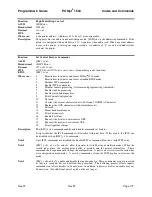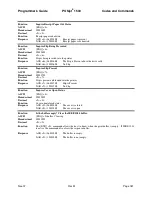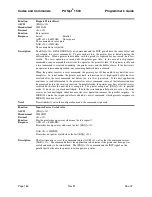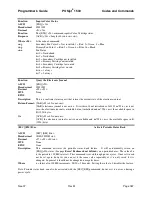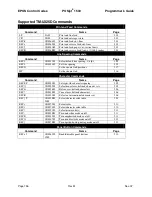
Codes and Commands
POSjet
®
1500
Programmer's Guide
Page 186
Rev M
Nov-07
Function
Inquire Error Status
ASCII
[ENQ] <22>
Hexadecimal
05H 17H
Decimal
<5> <22>
Function
The [ENQ] <22> command reports on the error status.
Response
[ACK] <22> <n> <r>
Where
<22> is the echo of the command ID.
<n>
is the number of return bytes + 40 (28H)
(to prevent confusion with XON/XOFF).
<r
1
>:
bit 0 = Cover is open.
bit 1 = Receipt paper is low
bit 2 = Receipt paper is out.
bit 3 = Ink is low (This is set if either cartridge is low)
bit 4 = Either or both cartridges are removed.
bit 5 = The auto cutter has faulted.
bit 6 = 1 always
bit 7 = An serious error has occurred.
Note 1:
If bit 7 is set, a serious error has occurred. The printer is not able to recover from type of an error
without operator intervention. If bit 7 is set without bit 5 (Auto-cutter fault) the print carriage has
faulted. This is probably caused by a paper jam or a component failure. The host system may
issue an [ENQ]<10> (Reset Request command) to attempt to recover. The Reset Request will
reset the printer to an initial power up state. All data will be lost.
Note 2:
When a serious error occurs (bit 7 set) the printer enters a static state. Status responses will
reflect the state of the printer when the error occurred.
Note 3:
For this status request to function during a serious error, the "Buffer Full Only" off line option
should be selected.
Function
Inquire User Store Status
ASCII
[ENQ] <23>
Hexadecimal
05H 17H
Decimal
<5> <23>
Function
The [ENQ] <23> command reports on the user store status.
Response
[ACK] <23> <Report> <0>
Where
<23> is the echo of command ID. The report is a null terminated string with the following
format:
12345[CR][LF] (Free user store)
12345 Type Name…[CR][LF]
(First entry) etc.
12345 Type Name…[CR][LF]
(Last entry) <0>
Type
The type field describes the type of information.
M = macro
C = character definition
Summary of Contents for POSJET 1500
Page 1: ...PROGRAMMER S GUIDE POSjet 1500 PN 20 03398 Rev M Nov 2007...
Page 14: ......






